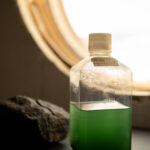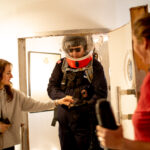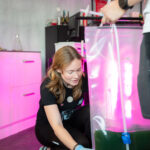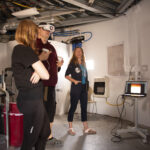Sol Summary – May 3rd
Crew 261 Sol Summary Report 03-05-2023
Sol: 3
Summary Title: experiencing EVA procedures in the windy environment of Mars
Author’s name: Aline Decadi, XO
Mission Status: Nominal.
Sol Activity Summary: Today took place 2 EVAs:
– EVA-3 with the following crew members: James Burk (Commander) (EVA Leader), Cecile Renaud (GreenHab Officer).
– EVA-4 with the following crew members: Aline Decadi (XO) (EVA Leader), Erin Kennedy (Crew Roboticist).
EVA-3 conducted a collection of soil for GreenHab experiments and operational testing of EVALink and VR-Comms procedures using Garmin devices. The soil collection is meant to support our Biostimulation experiments.
The crew drove with the Opportunity rover towards Cow Dung Road, took it South to the entry to Robert’s Rock Garden, and walked East to the collection site.
EVA-4 conducted Atmosphinder testing using the half-sized robot (~1 m diameter) in front of the Hab. The objectives of the test focused on
structural aspects of the robot and de-risking operational elements. The EVA crew members worked together to increase the operational understanding of extracting the robot out of the RAM, loading the robot into the rover (ATV), securing the robot to the rover (ATV), and driving slowly with sudden decelerations. The lessons learned from this exercise will de-risk these elements on future EVAs when transporting the robot to regions of interest. Quantitative testing of the robot was completed using force meters to measure the longitudinal and latitudinal forces required to lift the robot. Qualitative testing observed that the robot can roll down a small incline unassisted.
Structural elements on the robot that failed were known previously and can be repaired. The electronics payload was tested separately, with the new addition of the wind sensor compared to EVA-2. The EVA-4 worked smoothly, and valuable new information was learned. The success of this EVA-4 was in large part thanks to the EVA crew lead and the crew facilitating behind the scenes.
We spent the afternoon making analysis and processing yesterday’s experiments: the Musk observatory first Sun imaging; analyzing the soil samples collected for the GreenHab and Biostimulation experiments; and setting up the tomorrow’s experiments: robotics Atmosphinder, drone reconnaissance of campus with 4 waypoints. The Commander James Burk also made a detailed demonstration on MarsVR, showing the MDRS and the surrounding desert with very accurate details of the terrain, and also how we will be able to use the VR to plan out our EVAs and even see EVAs in progress.
The cardiovascular monitoring with requested parameters has been also performed as usual by HSO.
Biostimulation experiments are divided in 2 sections:
– early growth biostimulation using different kinds of soil (Utah soil, Martian
regolith simulant and normal soil).
– biostimulation on grown tomato plants.
Biostimulant solution is made from spirulina.
We spent the evening having dinner, the commander briefing, and preparing the experiments for tomorrow.
Look Ahead Plan: We will be in Sim tomorrow to perform a flyover of the campus using a drone, and to test out the Meshtastic devices for the VR, and make a complementary structural test for the Atmosphinder experiment, according to mission request approval.
Anomalies in work: Toilet is smelly, and Crew Engineer will cover that in Operations report.
Weather: Sunny and pleasant. Very windy day.
Crew Physical Status: Nominal
EVA: testing Atmosphinder prototype, drone reconnaissance of campus.
Reports to be filed: HSO Report, EVA Request, EVA Report, Operations Report, Journalist Report, Pictures of the day.
Support Requested: None.
Operations Report – May 3rd
Crew 261 Operations Report 03-05-2023
SOL: 3
Name of person filing report: Julien Villa-Massone
Non-nominal systems:
· Toilet
· Remote observatory
Notes on non-nominal systems:
Toilet started to smell a lot (making some crew mates uncomfortable when on the lower deck). Mission Support provided guidance:
1) Let’s fill the remaining toilet tank with water and empty it.
2) We need to make sure there are no leaks in the toilet/toilet tank:
Please inspect area in the toilet room for any leaks
In the EVA prep room please remove the toilet tank cover and inspect underneath with the flashlight to see if there any leaks
Crew Engineer applied this guidance. No evidence of leak was found. Over the course of the day, smell reduced. The smell level in the lower deck is slightly noticeable. In the toilet, the smell still exists, but it is not unbearable like it was before emptying.
Following up, Mission Support informed us that a septic tank cleaning was ordered and they should be at the bast tomorrow. Air freshener was offered if if smell continues.
We appreciate the help of Mission Support on this matter.
ROVERS
Spirit rover used: No
Hours: (before EVA) 220.3
Beginning charge: (Before EVA) 100
Ending charge: (On return from EVA, before recharging) N/A
Currently charging: Yes
Opportunity rover used: Yes
Hours: 123.0
Beginning charge: 100
Ending charge: 78
Currently charging: Yes
Curiosity rover used: Yes
Hours: 232.9
Beginning charge: 100
Ending charge: 99
Currently charging: Yes
Perseverance rover used: No
Hours: 262.8
Beginning charge: 100
Ending charge: N/A
Currently charging: Yes
General notes on rovers: Nominal operation today
Summary of Hab operations: Nominal day (toilet issue described above)
WATER USE: rate of 30 gallons / sol. Trend of 28 Gallons/sol since mission start. We are now on target to finish the mission 2 gallons short. (So we are essentially on target). This means, if we continue with this trend, the tank will be at 118 gallons when the mission ends.
Water (static tank): 388 gallons remaining
Static tank pipe heater (on or off): off
Static tank heater (On or off): off
Toilet tank emptied: yes
Summary of internet: Nominal
Summary of suits and radios: Suits: nominal. Radios: nominal. For information, as mentioned by Mission Support during initial training, we noticed that Radio #2 was unable to transmit reliably to the repeater on channel 1 (at 1.5km distance south, at the ridge), so the EVA crew decided to use channel 2 locally, and the crew member with the other radio would use channel 1 to communicate to Hab. Habcomm crew decided to have one radio on channel 1 and one radio on channel 2 to increase situational awareness.
Summary of GreenHab operations: GreenHab door closed earlier due to the wind
WATER USE: 6 gal at 06:30 + 4 gal
Heater: Off
Supplemental light: Off
Harvest: None today
Summary of ScienceDome operations: Nominal day with mainly work by Crew Biologist. Biostimulation solution prepared. Added culture + media to Bioreactor – now operational. Set up microscope to show crew Spirulina tomorrow.
Dual split: Off
POWER report: Nominal operations today. Crew Engineer drew a diagram of the power system components to gain a better understanding. The chart assumes 3 connections due to some wiring being hidden and inaccessible, but all other connections are visible and have been recorded and charted on the diagram. Logs analyzed to a limited extent, producing this graph. Crew Engineer started modeling the battery SoC based on VDC. Next, will attempt modeling according to Watt-hours. Battery charging / discharging seems nominal – generator has not required since mission start.
Power System SoC comes from the power system and seems to be inaccurate, as the SoC remains low and decreasing while the battery has positive watts (is charging). This is why Crew Engineer is attempting to model SoC.
Summary of RAM operations: Crew Robotics Engineer continued assembly and adjustments of the robot following a first EVA near the base for initial testing. Crew Engineer cut a spare PVC pipe (using a hand saw) to serve as support for a failed step in the Hab staircase.
Summary of any observatory issues: Nothing to report
Summary of health and safety issues: Nominal day
Questions, concerns and requests to Mission Support: Grateful for the continued support received from Mission Support. Thanks extended from the entire crew.
Journalist Report – May 3rd
Crew 261 Journalist Report 03-05-2023
Author: Kris Davidson, Crew Journalist
A strong wind arose during the afternoon of Sol 3, battering the hab for several hours. The fierce gusts elicited contrasting emotions; a sense of comfort as the crew found solace in their secure shelter, while concern lingered with each shake and rattle. The inhospitable conditions outside served as a stark reminder that critical structures can be damaged or compromised under the formidable Martian elements.
Winds have long defined Mars and remain an important area of study. Earlier in the day, prior to the intensification of the wind, the crew united to support Erin Kennedy, the Crew Robotics Engineer, as she embarked on her first on-site test of Atmosphinder. This innovative wind-powered rover is being designed to probe the geomorphic processes in the south polar region of Mars, an area known for its seasonal eruptions that contribute significantly to the planet’s atmospheric system. During EVA 4, Executive Officer Aline Decadi took the lead, offering valuable support as Kennedy worked with the robot, while Crew Commander James Burk supervised the team’s endeavors from the hab. Kennedy tested the robot using a half-sized design (~1 m diameter) in front of the hab. The objectives of the test focused on structural aspects of the robot and de-risking operational elements.
Cécile Renaud (Greenhab Officer + Crew Biologist) has been working steadily on two biology experiments, both with the overarching goal of understanding how future Martian settlers might successfully grow edible plants. The primary purpose of EVA 3, led by Crew Commander James Burk, was for Renaud to collect a variety of soil samples to use in a biostimulation project, in which spirulina (a stimulant) will be placed on tomato plants. Renaud and Julien Villa-Massone (Crew Engineer) have also successfully completed the setup of the photobioreactor device, intended to study the growth of spirulina in a Martian environment.
Transatlantic Mars 261 is comprised of safety-focused individuals, with a focus EVAs, among the most dangerous activity for an astronaut. Villa-Massone (Crew Engineer) installed a temporary monitor in the hab featuring a live EVA map feed, allowing HabComm to track the analogue astronauts in real time. Decadi (Executive Officer) polled the crew about the EVA spacesuits, compiling a list of areas of potential safety-focused improvement. Audrey Derobertmasure (HSO) has further improved the safety of EVAs by implementing a quick numerical (1 through 5) self-assessment of well-being, Each analog astronaut is queried at various points of an EVA by HabComm, a simple but valuable metric for recent hot Sols.
At 1700, the crew gathered in the lower hab for an enlightening demonstration of Mars VR by Commander Burk, who was joined in a virtual MDRS setting by project development partner Jeff Rayner of MXT Reality, based in Seattle, Washington. While still in the midst of a windstorm, the crew explored the virtual hab and surrounding landscape.
As the crew members of the Transatlantic Mars 261 mission press forward, they continue to confront the challenges and marvels that the Martian landscape has to offer. From the winds of Sol 3 to the intricacies of rover testing and the pursuit of sustainable plant growth, each day brings a wealth of learning experiences and opportunities for growth. With a focus on safety and a commitment to teamwork, the crew remains dedicated to advancing our understanding of Mars and its potential for future human habitation.
GreenHab Report – May 3rd
Crew 261 GreenHab Report 03-05-2023
GreenHab Officer: Cécile Renaud
Environmental control: Door open from 6:30 to 18:20
Average temperatures: 54°F at 06:30, 76,6°F at 10:15, 93,7°F at 14:30, 83,3°F at 18:30, 84,4°F at 19:00
Hours of supplemental light: N/A
Daily water usage for crops: 6 gal at 06:30 + 4 gal
Daily water usage for research and/or other purposes: 4 gal (including watering solution for biostimulant exp)
Water in Blue Tank 135,2 gallons
Time(s) of watering for crops: 06:30 and 19:00
Changes to crops: N/A
Narrative: GreenHab door closed earlier due to the wind.
Harvest: (include which crop and mass in grams) : None
Support/supplies needed: None
EVA Report – May 3rd
Crew 261 EVA Report 03-05-2023
EVA # 3
Author: James Burk, Commander
Purpose of EVA: Collection of soil for GreenHab experiments and operational testing of EVALink and VR-Comms procedures using Garmin devices.
Start time: 9:00 AM
End time: 10:15 AM
Narrative: EVA-3 conducted a collection of soil for GreenHab experiments and operational testing of EVALink and VR-Comms procedures using Garmin devices. The soil collection is meant to support our Biostimulation experiments. Commander James Burk and GreenHab Officer Cecile Renaud took the Opportunity rover on a traverse south to the north side of Kissing Camel Ridge (East), which is also just at the entrance of Robert’s Rock Garden. They parked the rover and walked east approximately 100 meters, stopping at three distinct sampling locations to collect different types of soil that will be used for the Biostimulation experiments. They also took Garmin waypoints and photos of the collection sites.
At the end of the EVA, James found a small rock that appears volcanic in origin. Cecile quickly named it “The Mountain”, and they brought it back to the Hab as a souvenir. Coincidentally, the name is very similar to James’ high school nickname. His high school sports teammate Karl Foston dubbed him “Mt. Burk” due to his height and his expertise with blocking basketball shots.
Destination: North side of Kissing Camel Ridge, just off Cow Dung Road.
Coordinates (use UTM WGS 84): 518300 E, 4249500 N
Participants: James Burk (Commander) (EVA Leader), Cecile Renaud (GreenHab Officer).
Road(s) and routes per MDRS Map: Drive towards Cow Dung Road, take it south to the entry to Robert’s Rock Garden, and walk east to the collection site.
Mode of travel: Rover (Opportunity)
Crew 261 EVA Report 03–05–2023
EVA # 4
Author: James Burk, Commander (with inputs from Aline Decadi, XO)
Purpose of EVA: Initial testing of Atmosphinder prototype
Start time: 11:00 AM
End time: 12:00 PM
Narrative: EVA-4 conducted Atmosphinder testing using the half-sized robot (~1 m diameter) in front of the Hab. The objectives of the test focused on structural aspects of the robot and de-risking operational elements. The EVA crew members worked together to increase the operational understanding of extracting the robot out of the RAM, loading the robot into the rover (ATV), securing the robot to the rover (ATV), and driving slowly with sudden decelerations. The lessons learned from this exercise will de-risk these elements on future EVAs when transporting the robot to regions of interest. Quantitative testing of the robot was completed using force meters to measure the longitudinal and latitudinal forces required to lift the robot. Qualitative testing observed that the robot can roll down a small incline unassisted. Structural elements on the robot that failed were known previously and can be repaired. The electronics payload was tested separately, with the new addition of the wind sensor compared to EVA-2. The EVA-4 worked smoothly, and valuable new information was learned. The success of this EVA-4 was in large part thanks to the EVA crew lead and the crew facilitating behind the scenes.
Destination: Flat ground just outside the hab. Originally the EVA was planned to go farther Northwest from Hab but once the team was out, they assessed that terrain from afar and felt that the terrain immediately in front of the Hab was lower risk for the experiment.










You must be logged in to post a comment.